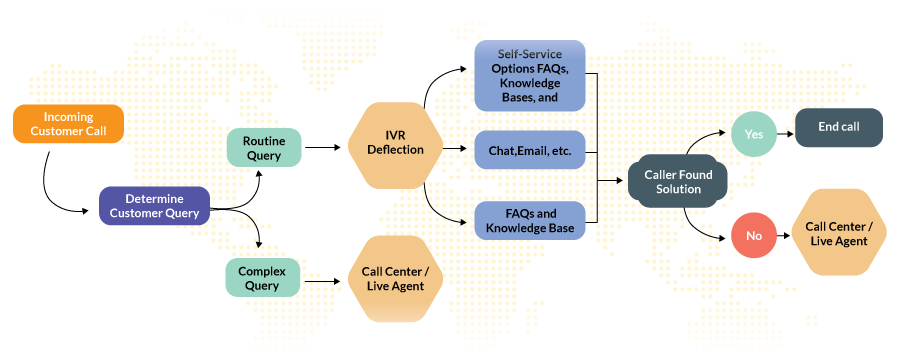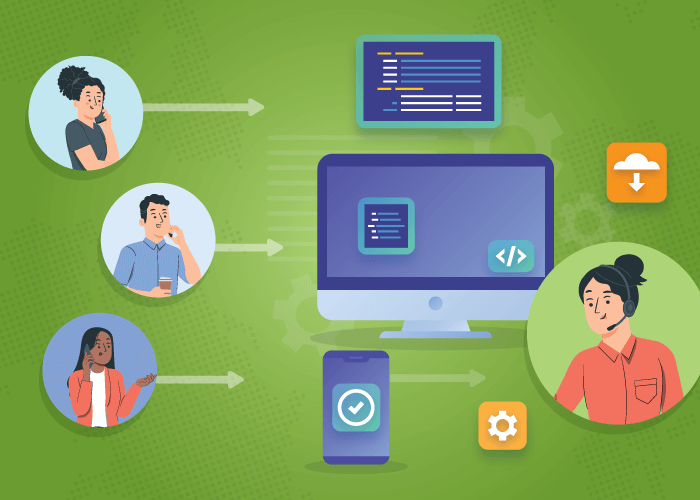If you didn’t already know — over 50% of customers are likely to abandon one business for another after a single bad experience. Compare this to research that shows customers are 2.4x times more likely to stay if their problems are solved swiftly.
These statistics prove that effective customer service plays a crucial role in customer retention and business growth.
Caller experience and customer experience are closely interconnected — especially for digital-only businesses — and can significantly impact each other. Did you know that more than 60% of customers resolve their problems with a business through a phone call?
Needless to say, call quality can influence customers’ perception of the brand, and a positive call experience is paramount to customer retention. But what happens if your teams cannot get to every customer call?
That’s where call deflection strategies come into play.
In this article, we’ll go over:
• Call Deflection: Definition and Benefits
• Differences Between Call Deflection and Call Forwarding
• 10 Call Deflection Strategies
- Personalize self-service options
- Implement IVR systems
- Leverage virtual assistants and chatbots
- Introduce web-based portals and mobile apps
- Provide FAQs and knowledge base
- Offer callback options
- Implement SMS/email notifications
- Leverage social media for support
- Empower agents with knowledge and tools
- Gather and act on customer feedback
What is Call Deflection?
Call deflection — in some cases, interactive voice response or IVR deflection — primarily focuses on diverting incoming calls related to customer inquiries from traditional voice calls to alternative channels. The process can vary depending on the businesses’ specific setup and requirements.
Call deflection can streamline operations and reduce customer effort. For example, you can manage high call volumes by executing an AI-powered chatbot and self-service options to deflect routine inquiries. In fact, a Gartner study predicts that chatbots, messaging, and machine learning apps will be part of 70% of customer interactions.
Deflecting incoming calls effectively will allow live agents to focus on complex issues and provide a better caller experience.
Benefits of Call Deflection
Implementing call deflection strategies and tools can bring several benefits to your business. They can help you streamline operations, reduce costs, enhance customer experience, and leverage digital platforms to meet the evolving needs and preferences of customers.
Here are some key advantages:
- Deflecting callers to other channels reduces live agent involvement, thereby optimizing resource use, decreasing staffing needs, improving efficiency, and ultimately lowering operational costs.
- You can reduce the likelihood of customers switching to competitors and increase customer retention rates.
- In a competitive market, call deflection can be the unique selling proposition that sets your business apart and attracts customers who prioritize excellent service.
- Satisfied callers are more likely to share their positive experiences with others, which can strengthen brand reputation and attract new customers.
- Digital channels and self-service options provide opportunities for you to collect valuable customer data.
Is Call Deflection the Same as Call Forwarding?
Call deflection should not be confused with call forwarding as they are two different call handling features used in cloud communications.
Call forwarding refers to redirecting incoming calls to another phone number or destination. And call deflection involves transferring an ongoing call to digital platforms or self-service options without ending the call.
A call forwarding destination can be a different local or international phone line or device, such as a mobile or landline. It can be set dynamically based on predefined rules, time of day, or availability. On the other hand, call deflection can be executed through IVR systems, where callers are presented with self-service options or redirected to other communication channels like chat, email, or frequently asked questions (FAQs).
Looking to switch to a new phone service? Check out our guide to the best call forwarding services.
Call Deflection at Different Stages of Caller Journey
Deflection solutions can be employed at different stages of the call journey. By doing so, businesses can reduce call volumes and improve the way customers interact with your business.
- Call arrival: At this stage, the need for live agents can be minimized with an IVR. You can encourage callers to resolve their queries through self-service or alternative channels.
- Information gathering: Use other channels to collect necessary details and guide callers to relevant resources.
- Escalation/transfer: Solutions like IVR or automatic call distributors (ACD) can streamline the caller journey and ensure callers are connected to the right agents or departments.
- Follow-up: At this stage, present callers with options for post-call support, or your team could reach out to customers to gather feedback.

10 Call Deflection Strategies to Improve Caller Experience
In a nutshell, call deflection strategies can help you offer greater convenience to your customers. You can do so by giving customers alternatives to traditional phone calls. By redirecting them to more efficient channels, these strategies can reduce call volumes, wait times, and customer frustration.
So, which solutions can be used to improve call deflection?
Here are 10 call deflection strategies widely used by businesses to improve caller experience:
- Personalize self-service options
- Implement IVR systems
- Leverage virtual assistants and chatbots
- Introduce web-based portals and mobile apps
- Provide FAQs and knowledge base
- Offer callback options
- Implement SMS/email notifications
- Leverage social media for support
- Empower agents with knowledge and tools
- Gather and act on customer feedback
1. Personalize Self-Service Options
Account-specific information, transaction history, order tracking, and other personalized self-service options empower customers to find solutions independently while receiving a tailored experience. Businesses can leverage customer data and preferences to offer relevant resources, FAQs, etc. through self-service portals or IVR systems. This lowers customer dependency on live agents and gives your customer interactions a good personalization boost.
2. Implement IVR Systems
An intelligent IVR system allows callers to quickly navigate through menu options and reach the appropriate department or agent without unnecessary transfers or waiting times. What’s exciting about IVR systems is that they use automated voice prompts and touch-tone input. This means callers can navigate any menu using their phone’s keypad or voice commands.
You can add multiple channels within your IVR such as voicemail, callback options, or simply direct them to online resources like your website or ticket center.
Global Call Forwarding offers a customizable IVR system to suit a wide range of business requirements. Get access to the IVR manager with any of our business phone number plans.
3. Leverage Virtual Assistants and Chatbots
Deploying chatbots and virtual assistants allows callers to interact via chat instead of making a call. Chatbots can handle routine inquiries, give instant responses, and escalate to live agents when necessary. For example, businesses can use chatbots to assist customers in tracking their orders, providing real-time status updates, and answering FAQs related to shipping, delivery, or product information, thereby reducing the need for customers to make a phone call for such inquiries.
These VAs can even interact with new potential customers and direct them to the right web pages to move them down the sales funnel. And in some cases, chatbot interactions can even help your teams qualify prospects and leads so they don’t waste time chasing after low-level leads.
4. Introduce Web-Based Portals and Mobile Apps
Offering web-based portals or mobile apps where callers can manage their accounts, access account information, make payments, or track orders can empower callers to perform tasks independently, reducing the need for calls. To get the best out of this, businesses should optimize their websites for mobile to ensure a seamless and user-friendly experience on smartphones and tablets.
5. Provide FAQs and Knowledge Base
Give callers access to comprehensive FAQs and knowledge base resources via self-service options or within an IVR system. This helps reduce their wait time and dependency on live agents. Callers also get standardized answers to common questions, ensuring accurate and consistent information is readily available. In fact, it is a good idea to share these resources with customers during the onboarding process. This way, when they call for assistance, your IVR can remind them to review the knowledge base or check their account for additional resources.
6. Offer Callback Options
Callers can be provided with the option to request a callback instead of waiting on hold. In this situation, callers leave their information and wait for return calls from your business. You can integrate this within your voicemail or have a separate smart callback feature that creates tickets or a callback queue. This way, customers can continue with their day and receive a call from a representative when it’s their turn.
7. Implement SMS & Email Notifications
Send callers proactive alerts via SMS or email related to their specific needs or interests. For instance, if a caller has recently purchased a product, an outbound IVR system or push notifications can automatically provide updates on the shipping status. This approach lowers uncertainty and reassures customers, increasing convenience and reducing reliance on calls.
8. Utilize Social Media for Support
It is quite common for businesses to engage with customers on social media platforms, addressing inquiries and concerns publicly. By responding to customers’ social media posts or direct messages, businesses can resolve routine issues eliminating the need for phone calls.
9. Empower Agents with Knowledge and Tools
Businesses should equip their live agents with comprehensive knowledge bases, training materials, and tools to address routine caller inquiries or issues quickly. This method of call deflection also frees up agents to focus on more complex or personalized interactions.
10. Gather and Act on Customer Feedback
By gathering customer feedback businesses can identify pain points and areas of improvement in the call experience. This data can not only be used to refine products and services but also to heighten caller experience over time.
Call Deflection Alternatives
Now, while the above-mentioned call deflection techniques can help manage call volumes, not every business has the resources and budget to acquire these tools. The end goal of call handling techniques is to provide better caller experience while alleviating call volumes. So, what if your business is unable to invest in chatbots or create a mobile app?
Here are some other ways to improve caller experience:
- Use an optimized call routing system to ensure that calls are directed to the appropriate department or agent. Use time-based or location-based routing to send calls to different locations when your main support center is overwhelmed. Or, use skills-based routing to match callers with representatives who can address really specific needs. This process helps to reduce the need for call transfers and improves first-call resolution.
- Provide live agents with easy access to customer details and clear call scripts. Utilize automation tools to simplify repetitive and time-consuming tasks like data entry and for initiating common processes. These measures enhance agents’ efficiency and minimize call handling time without compromising the quality of customer service.
- Use call recording and quality assurance processes to monitor agent performance and identify training needs. Evaluate calls for trends or recurring issues that can be addressed proactively. This process can help you refine call handling techniques.
Making the Most of IVR Deflection for Business Growth
IVR systems are extremely dynamic and can tremendously contribute to your business, especially to call management and caller experience. This system can optimize call handling, reduce wait times, provide contextual information, offer channel flexibility, and integrate self-service options. All of these actions can collectively empower businesses to deliver better customer service, streamline operations, and unlock growth opportunities.
Read more about the benefits of using an IVR System to get a better understanding of how IVR systems work and the benefits of using one.
Have more questions? Speak to an expert at Global Call Forwarding today!


